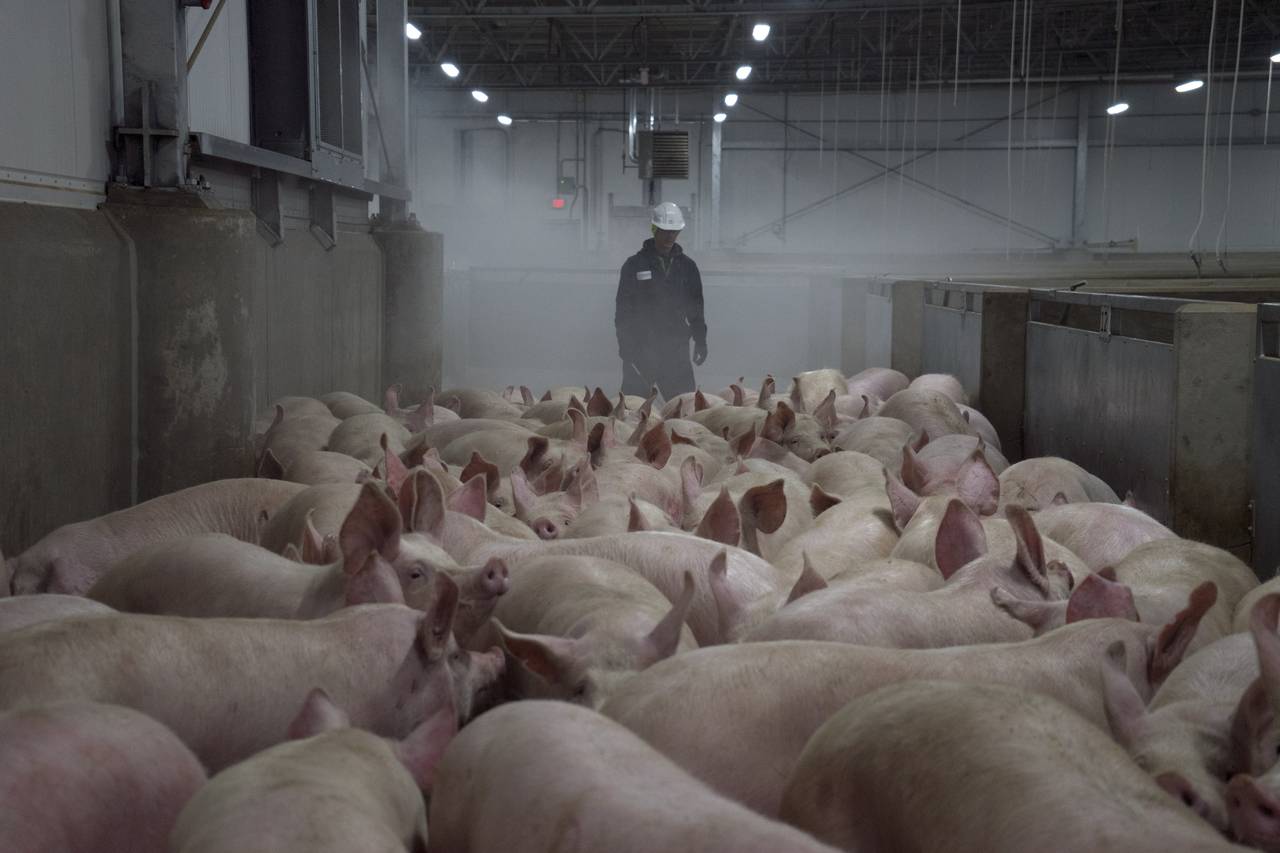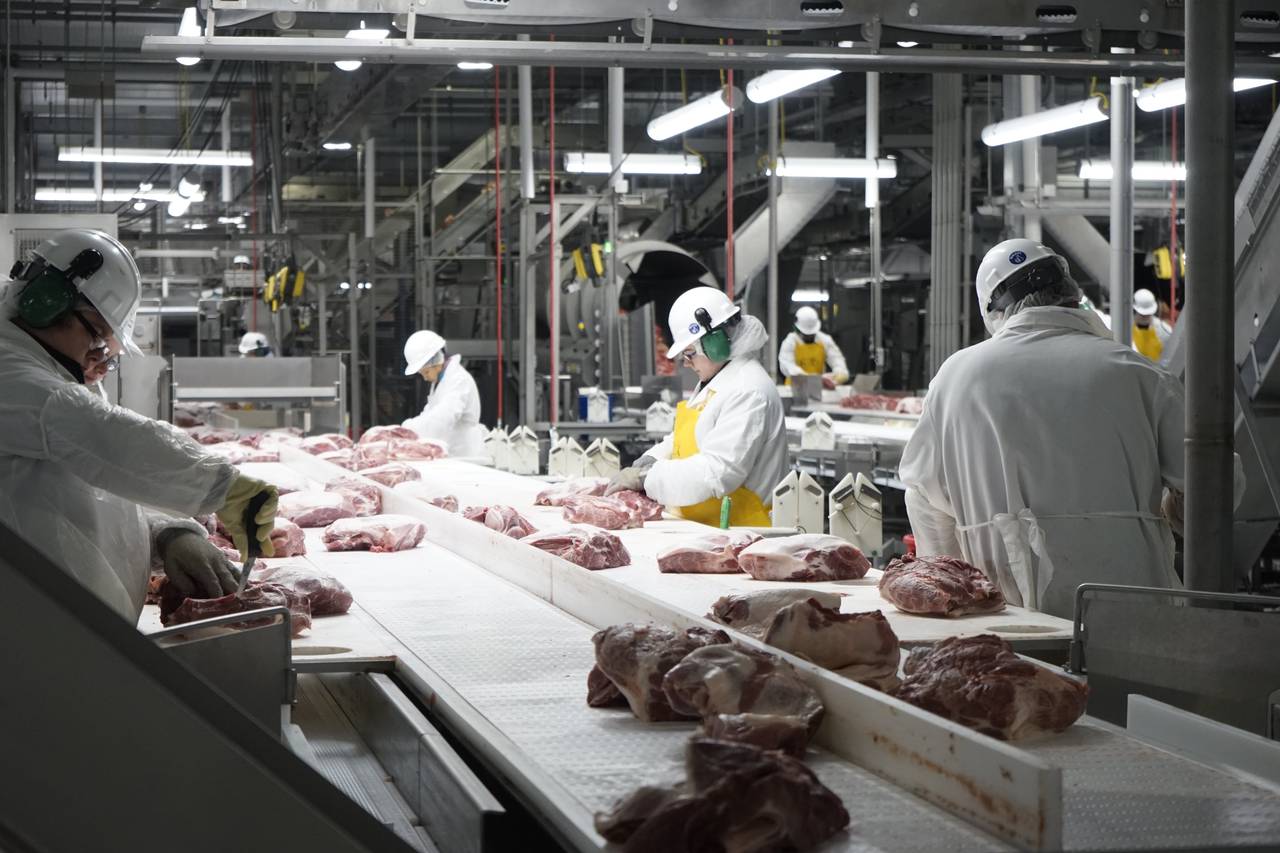WSJ: Proposed Rules Would Allow Meatpackers to Slaughter Hogs Faster

Hogs arrive for slaughter at a Clemens Food Group facility in Coldwater, Mich. Photo: Benjamin Parkin/The Wall Street Journal
By Benjamin Parkin and Patrick McGroarty | February 20, 2018
Critics say ideas risk pork cleanliness, worker safety
COLDWATER, Mich.—Proposed rules allowing meatpackers to slaughter hogs faster and play a bigger role in policing food safety are intended to free up government inspectors while making plants more efficient. But the rules, which could take effect this year, have drawn criticism.
Consumer advocates question whether companies can guarantee the cleanliness of their pork while workers take on some tasks previously reserved for U.S. Department of Agriculture inspectors. Meanwhile, worker-rights groups say speeding up slaughter lines would strain workers whose jobs are already difficult and dangerous.
Meat companies and the USDA say the proposals would make better use of inspectors and plant capacity without compromising food safety. Some meatpackers also say more efficient plants could mean lower pork prices for consumers. Similar inspection changes were made in the poultry industry in 2014, and officials say they could come next to the beef-inspection process.
“We can make a lot more efficient and effective use of the personnel we have,” said Paul Kiecker, acting administrator of the USDA’s food-safety branch. He said the moves would let inspectors perform other duties such as checking on plant sanitation, which the agency deems a better way to promote food safety than having an inspector posted only to monitor specific points in the slaughtering process.
The changes, some of which are optional and which are due to be completed after a public-comment period ends this spring, predate the Trump administration’s push for deregulation. The proposal is based on a pilot program of more than 15 years at five slaughterhouses run by companies including Smithfield Foods Inc., Hormel Foods Corp. and JBS SA.
JBS didn’t respond to requests for comment. Smithfield and Hormel referred inquiries to the North American Meat Institute, a trade group. Mark Dopp, the institute’s head of regulation and science, said under the new rules, inspectors “don’t have to stand out in the line every minute of every day.”
Inspection practices have fallen behind food-science and slaughterhouse technology, according to the USDA and meat companies, which say they didn’t lobby for the changes. Diseases such as tuberculosis that an inspector can identify by sight are less common in livestock today, they say, while more pressing threats such as bacterial contamination are detected through laboratory tests. They say plant workers can be trained to perform tasks, such as preliminary health checks on glands and organs in slaughtered animals, that were previously performed by inspectors.
The new rules were on display on a recent morning at a slaughterhouse in southern Michigan run by Clemens Food Group that is operating under a version of the new system. As workers in hard hats and blood-splattered coats butchered more than 1,000 hogs an hour into pork loins and St. Louis ribs, they also performed more food-safety checks.

Workers at the Clemens pork-processing plant in Michigan butcher the carcasses into cuts such as loins and ribs. About 800 people work at the facility. Photo: Benjamin Parkin/The Wall Street Journal
Hogs weighing more than 250 pounds trotted off trucks into the 635,000-square-foot facility, where workers removed animals that were limping or appeared ill. After healthy hogs were slaughtered and their carcasses strung up on metal bars, workers carved them up, squirting indigo dye on heads and offal that looked potentially infected or contaminated. Three USDA inspectors, down from seven under the traditional system, checked to make sure the meat sent onward was safe.
Consumer advocates say the new approach would make it easier for employees and inspectors to overlook suspect animals and meat, potentially allowing pathogens such as salmonella to slip into the food supply.
“Replacing…inspectors with company personnel is a scary proposal,” said James E. Rogers, a former USDA employee who is now director of food safety at watchdog Consumer Reports.
Food-safety advocates say the moves could lead to problems similar to those they have identified in poultry processors, which also underwent rule changes. Food & Water Watch found that 30% of chicken plants using fewer federal inspectors exceeded the USDA’s threshold for salmonella contamination between October 2016 and December 2017, compared with 13% of plants operating under the traditional system.
The USDA said the higher rate of violations were because of one company. More than half of the plants that failed the standard were operated by Sanderson Farms Inc., according to Food & Water Watch. Chief Executive Joe Sanderson said the poor performance was because the company didn’t adequately reconfigure its lines to the USDA’s standards, doing the bulk of salmonella-related sanitation after inspectors had taken samples. He said the company was addressing that.
The USDA added that poultry plants involved in a pilot effort had a lower salmonella rate than the rate for all plants, and it expects rates among new entries to drop as they adjust their plants to the latest system.
A 2013 USDA audit found that food-safety officials allowed the hog plants in the long-running pilot program to operate without sufficient oversight, resulting in high rates of regulatory violations at some facilities. Critics add that companies that adopt the rules won’t be required to give extra training to employees taking on inspection duties. “The available evidence suggests that these changes will undermine food safety,” said Rep. Rosa DeLauro (D., Conn.).
Mr. Kiecker, the USDA food-safety administrator, said violations at plants in the pilot program were more frequent because the system freed inspectors to catch more food-safety threats. And while additional training for employees wasn’t required, he said meatpackers would fail the agency’s standards without it.
Worker-rights advocates have criticized the new proposal because it would eliminate a cap that limits the number of slaughtered hogs to just more than 1,100 hogs per hour. “This is really backbreaking hard work,” said Deborah Berkowitz, a senior fellow at the National Employment Law Project. “We’re very concerned about worker safety in those plants.”
Meatpackers say they won’t run plants faster without adding employees. The Clemens plant slaughters about 8,000 hogs a day, or roughly one every three seconds. About 800 people are employed there, working alongside robotic slicing machines to butcher carcasses, or scraping blood and bits of flesh off equipment and concrete floors. The company hopes to boost output to as many as 20,000 hogs a day by adding a second shift, more workers and faster line speeds, said plant manager Randy Zorn.
Higher output wouldn’t compromise the plant’s attention to food or worker safety, Mr. Zorn said. “The USDA and companies still have a common responsibility to ensure consumers are protected. That hasn’t changed.”
—Jacob Bunge contributed to this article
Write to Benjamin Parkin at Benjamin.Parkin@wsj.com and Patrick McGroarty at patrick.mcgroarty@wsj.com